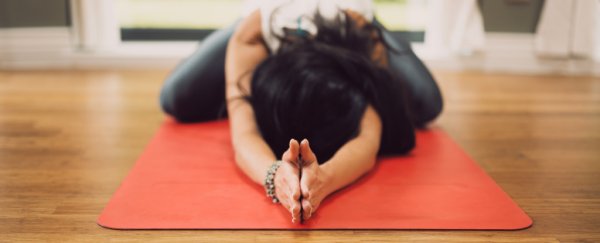Whether you're striding into the new year resolved to up your daily step count or keen to lift some weights, you might want to think about adding some stretching to your day, too.
New research suggests that stretching might be more effective than brisk walking at lowering high blood pressure for people with hypertension.
"Everyone thinks that stretching is just about stretching your muscles," said Phil Chilibeck, who studies biomechanics and human movement (kinesiology) at the University of Saskatchewan in Saskatoon, Canada.
"But when you stretch your muscles, you're also stretching all the blood vessels that feed into the muscle, including all the arteries."
This reduces the stiffness in your arteries, meaning there's less resistance to blood flow, which may result in lower blood pressure.
High blood pressure is a leading risk factor for cardiovascular diseases, which are the number one cause of death globally.
Though it can be difficult, there are plenty of things people can do to bring their blood pressure down, such as reducing their salt intake, drinking less alcohol, or spending time with family and friends.
And perhaps we could add stretching exercises to the list, too.
Previous studies, in animals and people, have shown how stretching can improve blood flow to muscles and tissues. One trial also found stretching was an effective way for women (with normal blood pressure) to reduce blood pressure during pregnancy, more so than walking.
Not to mention that stretching strengthens connective tissue, improves flexibility, and helps our bodies adapt to increasing exercise.
In this study, stretching went head-to-head against brisk walking in an eight week trial involving people with moderately elevated blood pressure.
Nearly forty men and women, averaging 61 years old, completed the trial. The participants didn't know what the trial was testing, only that they had to complete their assigned exercises, either stretching or walking.
One group did a 30-minute stretching session five times a week, while the others went walking for the same amount of time, and at a brisk pace to elevate their heart rate.
Before and after the eight week program, the research team measured the participants' blood pressure in three ways: when people were seated (like you would be in a doctor's office), lying down in the supine position (which may be more precise for measuring hypertension) and over a 24-hour period using a portable blood pressure monitor.
It helps that both groups had similar dietary salt intakes, and assessments also showed the study participants didn't reduce their typical physical activity to make time for the extra exercise, but rather added it on top of their usual routine.
After eight weeks, and with blood pressure readings adjusted to baseline and averaged for each group, stretchers had greater reductions to their blood pressure compared to walkers by some measures, but not all.
"This finding is important as it offers people a greater number of exercise options for reducing blood pressure," the authors wrote in their paper.
As for how exactly stretching lowers high blood pressure, that still needs further investigation.
Aside from easing blood flow, it might have something to do with the slow controlled breathing that naturally accompanies stretching. Breathing exercises in yoga practices have been linked to lower blood pressure, but this also means it would be difficult to separate the effects of breathing from stretching itself.
Plus, the study participants were only supervised a few times a week, so we have to take them at their word that they completed the other sessions to the same standard.
We also need to recognise that the trial recruited a relatively small group of men and women, and only 35 completed the full eight week program.
Beyond this, we can't say if stretching had a sustained effect because the benefits might fade as soon as people stopped stretching, and we all know it can be hard to make new habits stick.
But above all, these findings are no reason to slow down on other forms of exercise.
The walking group in this small study managed to reduce their waistlines more so than those stretching, which shows it's still a good idea to get the heart pumping with aerobic exercise, such as walking.
"Things like walking, biking, or cross-country skiing all have a positive effect on body fat, cholesterol levels, and blood sugar," said Chilibeck, who along with his co-authors concluded it might be best to add a stretching routine to aerobic exercise for your overall heart health.
At the very least, this research might just be the nudge we need to incorporate an activity we can do rain, hail or shine.
The study was published in the Journal of Physical Activity and Health.
